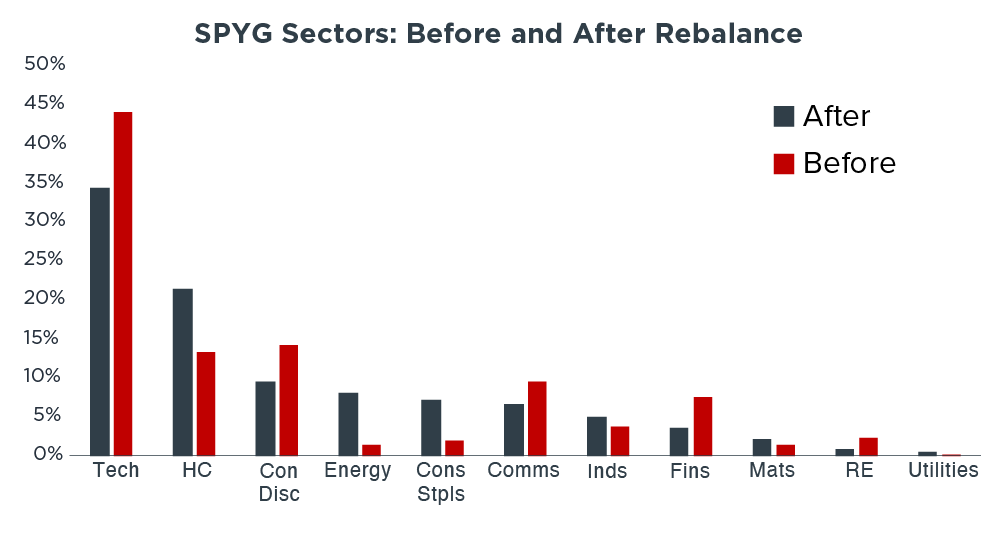Up is down, and down is up
Two key components of the equity market—growth stocks and value stocks—are looking significantly different as 2023 gets underway, which could have important implications for investors. Consider the S&P 500 Growth Index and the S&P 500 Value Index—two major style-based stock indices with more than $80 billion of ETF assets tied to them1. Last month, both indices underwent their annual rebalance to reflect their recent performance. And because value stocks trounced growth shares in 2022, the makeup of these two indices saw some significant shifts. Look at the chart below, which shows the sector breakdown of the S&P 500 Growth Index before and after its December rebalance.- Tech stocks—the traditional poster children of the growth stock universe—saw their weighting in the Index fall by 9.7 percentage points, from 44.2% to 34.5%.1
- In contrast, two sectors often associated with value stocks—health care and energy—now represent a much more significant percentage of the growth Index than before the rebalance.

Source: Bloomberg 1/10/23. SPGY = S&P 500 Growth Index.
A big reason for these shifts: Recent price momentum is a key factor in determining the S&P 500 Growth Index’s sector weightings. While tech stocks plummeted in 2022, health care performed relatively well—and energy shares soared by more than 60%.1 All this has resulted in some developments that may seem straight out of Bizarro World. For example:
- Amazon now has a larger weight in the value index than in the growth index.
- Both Netflix and Meta (Facebook) are now only in the value index and not the growth index.
1 Source: Bloomberg 01/10/23 This commentary is written by Horizon Investments’ asset management team. Past performance is not indicative of future results. Nothing contained herein should be construed as an offer to sell or the solicitation of an offer to buy any security. This report does not attempt to examine all the facts and circumstances that may be relevant to any company, industry, or security mentioned herein. We are not soliciting any action based on this document. It is for the general information of clients of Horizon Investments, LLC (“Horizon”). This document does not constitute a personal recommendation or take into account the particular investment objectives, financial situations, or needs of individual clients. Before acting on any analysis, advice, or recommendation in this document, clients should consider whether the security in question is suitable for their particular circumstances and, if necessary, seek professional advice. Investors may realize losses on any investments. The investments recommended by Horizon Investments are not guaranteed. There can be economic times when all investments are unfavorable and depreciate in value. Clients may lose money. Asset allocation cannot eliminate the risk of fluctuating prices and uncertain returns. Low-volatility investing is not a guarantee against loss or declines in the value of a portfolio. All investing involves risk of loss, and in periods of market growth, risk mitigation strategies can be expected to lag in performance behind equity strategies that do not focus on risk mitigation. This commentary is based on public information that we consider reliable, but we do not represent that it is accurate or complete, and it should not be relied on as such. Opinions expressed herein are our opinions as of the date of this document. These opinions may not be reflected in all of our strategies. We do not intend to and will not endeavor to update the information discussed in this document. No part of this document may be (i) copied, photocopied, or duplicated in any form by any means or (ii) redistributed without Horizon’s prior written consent. Forward-looking statements cannot be guaranteed. The S&P 500 Index is a stock market Index tracking the stock performance of the 500 largest companies listed on stock exchanges in the United States. The S&P 500 Growth Index serves as a proxy for the growth companies included in the S&P 500 Index. The S&P 500 Value Index serves as a proxy for the value companies in the S&P 500 Index. References to indices or other measures of relative market performance over a specified period of time are provided for informational purposes only. Reference to an index does not imply that any account will achieve returns, volatility, or other results similar to that index. An index’s composition may not reflect how a portfolio is constructed in relation to expected or achieved returns, portfolio guidelines, restrictions, sectors, correlations, concentrations, volatility or tracking error targets, all of which are subject to change. Individuals cannot invest directly in any index. Other disclosure information is available at www.horizoninvestments.com. Horizon Investments and the Horizon H are registered trademarks of Horizon Investments, LLC ©2022 Horizon Investments LLC

